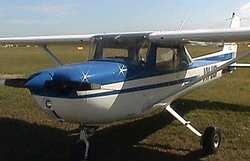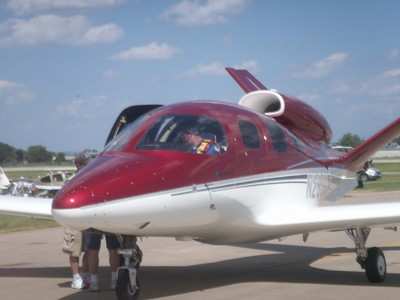Working With Industry To Study Changing Part 23 Rules
By: Chris Batcheller
 We may have to put away our FAA
jokes, or at least some of them. The FAA has been working with the
various aviation industry groups to study changing the Part 23
Rules to make it easier and faster to certify a Part 23 airplane.
Finally they may be able to say “We’re with the FAA and
we’re here to help”.
We may have to put away our FAA
jokes, or at least some of them. The FAA has been working with the
various aviation industry groups to study changing the Part 23
Rules to make it easier and faster to certify a Part 23 airplane.
Finally they may be able to say “We’re with the FAA and
we’re here to help”.
The FAA has worked for the last 18 months with the EAA, AOPA,
NBAA, GAMA, AEA and other aviation organizations to study the Part
23 Certification Process and make recommendations for the next 20
years. A similar process was conducted in March 2002 for Part 25
regulations. The result of this work has been a report of
recommendations to the FAA. The team made a total of 56
recommendations with 5 key focus areas. The results of this work
can be read in “Part 23 – Small Aircraft Certification
Process Study, Recommendations For General Aviation For The Next 20
Years”.
What does this mean for the general aviation aircraft
owner? The short answer is, lots of good things. With the
advent of technology, the old Part 23 regulations are cumbersome
both on aircraft manufacturers and the Federal Aviation
Administration. The FAA has recognized that it can’t do
business as usual, and its enlisted industry to help collaborate on
the new process.
The first key area is to make the regulations complexity and
performance based in place of the current weight and type based
rules. This is probably the most strategic change that was
recommended.

FAA John Colomy
The recommendation calls for aircraft to be placed in one of
three categories: Type I, II and III. The categories would be
divided by performance and complexity. A Type I airplane would not
be more complex and have the performance up to that of a Cessna
150. Type I would be limited to 14,000 feet and must have a stall
speed less than 61 knots. These airplanes must be unpressurized and
have generally simple structures and systems.

A Type II airplane includes all airplanes from, for example, a
Cessna 150 to a Cirrus Vision. They would have a maximum altitude
of 25,000 feet and a maximum speed less than Mach 0.6. This maximum
speed aligns with EASA. The airplanes may be pressurized, have
conventional control systems, construction and configuration.

Cirrus Vision
The third group would include very high performance and complex
aircraft such as the Cessna CJ4. This group would have unlimited
performance and complexity.
The idea is that the rules would be tailored to meet the
performance and complexity for each group. It is very easy to
understand that a light single engine should be certified to less
stringent rules than a business jet. Under today’s rules,
with some exceptions they are certified under the same rules.
I think that this is a step in the right direction and I hope
that the FAA is able to follow through with such a massive change.
I would like to see an extra category inserted between the Type I
and Type II to include unpressurized medium complexity airplanes
such as a Cirrus SR22 or a Beechcraft Bonanza type airplane.
(Chris Batcheller, ANN)
The recommendation was also made to coordinate these rule
changes with certification agencies around the world to obtain a
global standard for the design and certification of airplanes
weighing 19,000 lbs or less.
The next recommendation was to improve on “Approved Model
List” for Supplemental Type Certificates or AML-STC’s.
Doing this will make it easier to complete modification to a
product, particularly installing avionics.
Next was development of a process to approve ICA’s or
“Instructions For Continued Airworthiness”. The FAA has
a process to approve AFM and AFM flight manual supplements and the
recommendation was to develop a similar process for
ICA’s,
A recommendation led by the EAA was to add regulations that
consider the degradation of aircraft over time. They advised that
the FAA develop an advisory circular to be used as a “Best
Practices Guide”.
The FAA led the recommendation on Data Management . They
recognized that the FAA uses little modern technology to deal with
data and that this area could be improved upon. They also noted
that for Part 23 Airplanes, the SDR (Service Difficulty Reporting)
system is not used often and that a solution needs to be developed
so that data can be collected and used to improve aviation
safety.
The final category dealt with pilot interfaces. This
recommendation was to “get back to stalls and stall recovery
techniques” and to “do it in simulators, do it in
airplanes”. They also recommended that the FAA inform pilots
about load limits. Particularly that staying below Va, maneuvering
speed only protects the airplane from structural damage in pitch.
It does not protect the pilot in yaw or roll. They also recommended
that the FAA should encourage business jet pilots to fly at Vref or
Vref -5 in place of the current Vref +/- 5. This is in response to
several accidents where business jets run off the ends of
runways.
The FAA’s next chore is to develop and implementation
plan. Starting in the fall, the FAA will conduct a regulatory
review of Part 23, and they will use this report as a basis for
changes to the regulations. They plan on holding a series of public
and industry meetings. We will see what the future holds. The hope
among some is that it will make it less expensive and easier to
certify a small airplane.
Copies of the report can be requested from the FAA Aircraft
Certification Service, Small Airplane Directorate in Kansas City,
MO.
 ANN's Daily Aero-Linx (04.15.24)
ANN's Daily Aero-Linx (04.15.24) Classic Aero-TV: 'No Other Options' -- The Israeli Air Force's Danny Shapira
Classic Aero-TV: 'No Other Options' -- The Israeli Air Force's Danny Shapira Aero-News: Quote of the Day (04.15.24)
Aero-News: Quote of the Day (04.15.24) Airborne 04.16.24: RV Update, Affordable Flying Expo, Diamond Lil
Airborne 04.16.24: RV Update, Affordable Flying Expo, Diamond Lil ANN's Daily Aero-Term (04.16.24): Chart Supplement US
ANN's Daily Aero-Term (04.16.24): Chart Supplement US






